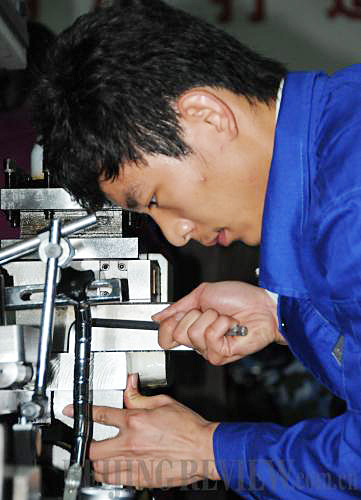|
 |
|
FIRSTHAND LEARNING: A student operates computer-controlled machine tools at a practical skills competition for vocational college students in Fujian Province (LAI JIANQIANG) |
For many Chinese people, the beginning of 2011 holds the promise of a fresh round of education reforms, which are expected to boost the country's education quality through increasing government investment, narrowing gaps between urban and rural schools, achieving internationally acknowledged higher education and reducing academic corruption and bureaucracy.
The Medium and Long-term National Educational Reform and Development Plan (2010-20), the guideline for China's education reform for the next decade, was approved by the State Council in May 2010.
The government is promoting educational fairness as a basic policy and increased education investment in rural, remote and ethnic minority areas.
Ambitious goals
According to the landmark reform plan, government investment will increase steadily to support the education sector, with education expenditure amounting to 4 percent of the GDP by 2012.
In 2008, the ratio stood at 3.48 percent, compared with the average international level of 4.5 percent.
China first pledged to increase its education spending to 4 percent of the GDP in 1993, but has, so far, failed to achieve the target.
The plan, which took one year and nine months to draw up and invited public submissions on two separate occasions, was seen as setting the tone for the development of the education sector, which has long suffered from funding shortages and unbalanced development between rural and urban areas.
The development of education, ranging from preschool education to vocational education in rural areas, will be a priority of the country's overall development programs, according to the plan.
The 22-chapter plan says preschool education should be basically universal by 2020, and the nine-year compulsory education policy should be consolidated.
The enrolment rate for senior middle school should be 90 percent of school age children, while the enrolment rate for higher education should be 40 percent of high school graduates.
Fully braced
In November 2010, the State Council set up the country's first national education consulting committee, whose main function is to give advice on the pilot programs of China's education reform.
The 64 consulting members, with an average age of 63, include former school principals, national lawmakers, political advisors and academicians.
At the end of November 2010, the Ministry of Education issued an action guideline for a three-year program to overhaul the country's middle-level vocational education. The key measures included building model schools and field training bases, fostering cooperation between enterprises and schools in the curriculum development and promoting cooperation between western regions, where vocational education facilities are backward, and the eastern regions, where vocational schools cannot recruit enough students. Creating disciplines to train graduates with agricultural skills is also a priority.
On December 5, 2010, the State Council released a notice announcing the initiation of pilot programs for the national education reform and listed 10 tasks. In the same month, the Ministry of Education released 11 pilot programs and selected areas and education institutions to carry out these programs. The missions of the programs include reducing the workload for primary and middle school students, improving the administrative systems of institutions of higher learning and promoting the participation of the private sector into education.
| 